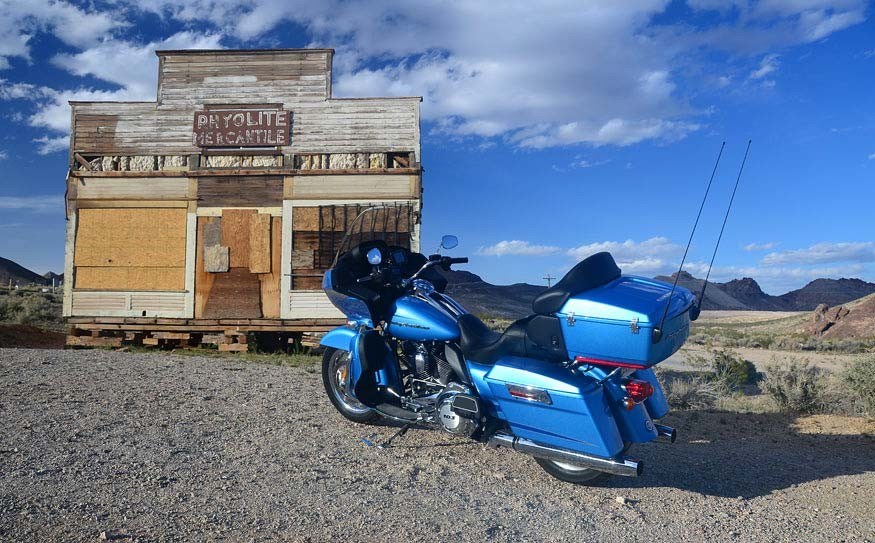"I never found the companion that was so companionable as solitude."
– Henry David Thoreau: Walden (1854)
It feels like the middle of freaking nowhere: terrain so remote, so inhospitable, that at one time the government set off above-ground nuclear explosions here. Maybe they hoped no one would notice. It's an area inhabited by space aliens and harbouring secret UFO landing sites, if you believe conspiracy theorists.
In short, the ideal place for a motorcycle journey. Once you get past the glitter, girls, and gambling of Las Vegas, Nevada is primarily desert. Its population density is less than 20 per square mile (a figure that presumably doesn't include rattlesnakes or space aliens), although Nevada is the seventh-largest state in land area. That's a lot of lonely desert. Which makes for lots of lonely highways — the best kind, from a rider's perspective.
Yes, the desert can be a harsh mistress, but I'm prepared. My rented Harley-Davidson Road Glide Ultra is one of Harley's top touring machines. Its ample storage capacity and six-gallon fuel tank ensure I won't run out of gas in the middle of nowhere — which is right where I want to be.
I'm tooling along the "Loneliest Road in America" — U.S. Highway 50, which runs east-west through the middle of the state. From Fallon, Nevada, riding east, I won't see another town for180 kilometres.
Twenty-five years ago, a story appeared in Life magazine claiming that U.S. 50 through Nevada contained "no points of interest," and recommended motorists not drive here "unless they're confident of their survival skills."
"We were somewhere around Barstow on the edge of the desert when the drugs began to take hold."
- Hunter S. Thompson: Fear and Loathing in Las Vegas (1971)
I'd ridden out of Las Vegas a couple of days earlier for a brief, scenic detour through Death Valley before heading north to Fallon, Nevada. At the junction of U.S. 95 and 50 in Fallon, I point my wheels eastward on the state's "Loneliest Road." Route 50 parallels the original Pony Express route, and is also part of the Lincoln Highway, the nation's first cross-country highway.
In the distance I spot what looks like a giant sand dune with ants crawling all over it. As I get closer, I see the "ants" are actually dozens of dune buggies, ATVs, and dirt bikes, which seem to emit the collective sound of a million angry bumblebees. The dunes are a naturally occurring and constantly shifting feature of Sand Mountain Recreation Area.
Continuing east, I cruise contentedly over miles of open road, open range, and high desert, with the snow-capped Toiyabe Mountains in the distance. I spend the night in the former silver-mining town of Austin. "This is wide open country here," Kip Helming, owner of Union Street Lodging in Austin, tells me. "You get up in these mountains, you can see 50, 60 miles (80 to 100 km) or more."
The next morning, I dodge snow flurries as I ride from town, and the mountains nearby are dusted in soft white powder. Travelling on two wheels in below-freezing temperatures, it's hard to imagine that I'd travelled through the intense heat of Death Valley just a couple of days earlier.
Late afternoon, I arrive in Ely, my last stop on America's Loneliest Road. From here, I would loop back south and explore Area 51 before returning to Vegas, where my trip began. Just a mile from downtown Ely, amidst darkening clouds, the skies suddenly open up — it's a full on, Katie-bar-the-door, thunder, lightning, snow, and hailstorm, instantly coating the road with thick slush. Fortunately, my hotel is nearby, but by the time I pull into its parking lot to seek shelter, the storm subsides.
The six-story Hotel Nevada and Gambling Hall (http://hotelnevada.com) is a genuine remnant of Nevada history; it was the state's tallest building when it opened in 1929. The Nevada Northern Railway (http://nevadanorthernrailway.net) also sits nearby, established in the early part of the twentieth century to transport copper ore from the nearby mines. The railway is a National Historic Landmark, a "working museum," home to a variety of early steam and diesel locomotives.
"The Truth is Out There"
- The X-Files (1993-2002)
Visitors from space notwithstanding, Nevada really hasn't changed that much since its Wild West days. In its nearly-deserted former boomtowns, you can almost feel the presence of the grizzled prospectors who rode in on burros, and it's easy to imagine the thriving gambling parlours, honky tonks, and bawdy houses that catered to their wants and needs. In the desert, you'll find all sorts of ghosts — real or imagined — and relics of the past. Mining detritus, rusting car parts, and shattered fragments of old whiskey bottles dot the landscape, remnants of hopes and dreams realized but ultimately lost. There's only one officially designated "Loneliest Road" here — U.S. 50 — but nearly all Nevada's roads are lonely.
Happy trails!
For more information visit the Nevada Tourism website at travelnevada.com. Other useful resources include: America's Byways—Highway 50: byways.org/explore/byways/2033 and Nevada's Pony Express route: ponyexpressnevada.com/pony-express-loneliest-road.html Glen Abbott's website can be found at travelingringo.com




